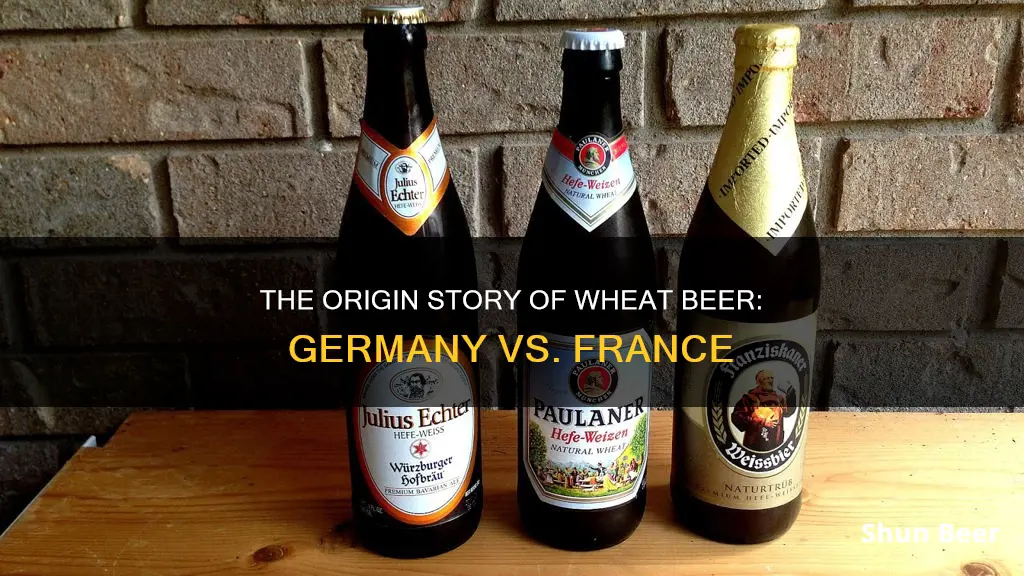
Wheat beer is a top-fermented beer made with a large proportion of wheat and is typically light in colour, low to medium in alcohol content, and can be cloudy or clear. Wheat beer is made by a number of large and small brewers and is not typically associated with a particular country. However, the most widely known wheat beer is Hefeweizen, a refreshing style from Germany. Wheat beer is also brewed in Belgium and France.
| Characteristics | Values |
|---|---|
| Place of origin | Germany |
| Common names | Weizenbier, Weizen, Weißbier, Hefeweizen, Weisse, Weizenbock, Witbier, Bière Blanche |
| Main varieties | German Weizenbier, Belgian Witbier |
| Other types | Lambic, Berliner Weisse, Gose |
| Ingredients | Wheat, barley, hops, yeast |
| Appearance | Cloudy, pale |
| Flavour | Banana, clove, coriander, orange peel, bubblegum, citrus |
| Alcohol content | Low to medium |
| Bitterness | Low |
What You'll Learn

Wheat beer is German, but France has its own varieties
Wheat beer is a category of beer that originated in Bavaria, Germany, dating back to the Middle Ages—and some argue, to the first century AD. It is typically a top-fermented ale, with at least 30% wheat in the brewing process, and comes in a variety of styles. The most widely known wheat beer is Hefeweizen, a refreshing style from Germany that's popular around the world. Wheat beers are typically light in colour, low to medium in alcohol content, and can be cloudy or clear in appearance.
The two main varieties of wheat beer are German Weizenbier and Belgian Witbier. German Weizenbier, or Hefeweizen, is a wheat beer traditionally from Bavaria, where a significant proportion of malted barley is replaced with malted wheat. It is known for its cloudy appearance, fruity notes (such as banana and citrus), and a slight spiciness from the yeast.
While wheat beer originated in Germany, France has its own variety known as Bière Blanche or French Bière Blanche. This style is similar to Belgian Witbier, embracing a hazy appearance and sometimes incorporating local ingredients for a unique twist.
Wheat beers go by different names in different countries and regions. In Germany and the surrounding region, it is known as Weißbier (in Bavaria and Austria), Weizenbier or Weizen (in Northern and Western German regions), and Kristallweizen (in Austria). In Belgium, it is called Witbier or Wit; in the Netherlands, it is Witbier or Witte; and in France, it is Bière Blanche.
IPA vs Wheat Beer: Which Style is Heavier?
You may want to see also

German wheat beer is known as Weizenbier or Weizen
Wheat beer is a top-fermented beer that is brewed with a large proportion of wheat relative to the amount of malted barley. German wheat beer, known as Weizenbier or Weizen, is one of the two main varieties of wheat beer, the other being Belgian witbier.
Weizenbier, or Hefeweizen, is a wheat beer that is traditionally from Bavaria. It was introduced to the region in the 15th century from neighbouring Bohemia. In Bavaria, wheat beer was initially reserved for the upper classes, with only the Duke of Bavaria and a few other nobles allowed to brew it. It wasn't until 1548 that wheat beer was allowed to be brewed and sold more widely in the region.
The name Weizenbier comes from the German word for wheat, "weizen", and the German word for yeast, "hefe", which gives the beer its cloudy appearance. Weizenbier is typically brewed with at least 50% malted wheat and is known for its distinctive fruity and spicy flavours, particularly banana and clove. It is also noted for its low hop bitterness and high carbonation.
Weizenbier is usually served in a large, curvaceous glass known as a weizen vase, which showcases the beer's appearance and helps to maintain its large head of foam. While it is sometimes served with a slice of lemon or orange, particularly in Austria and the US, this practice is not traditional in Bavaria and is generally frowned upon.
Sam Adams Octoberfest: Wheat Beer or Not?
You may want to see also

French wheat beer is called Bière Blanche
Wheat beer is predominantly made using wheat with a touch of barley, giving it a uniquely light and refreshing profile. The two main varieties are German Weizenbier and Belgian witbier. However, French wheat beer, known as Bière Blanche, is also a popular style.
Bière Blanche, or Witbier in Flemish, means "white beer", which refers to the use of wheat as one of its most important ingredients. Wheat is used alongside barley malt to create the fermentable base, with the percentage of wheat in the total grains typically reaching 50%. In rarer cases, the wheat content can be as low as 30-40%.
French wheat beer embraces a hazy appearance, similar to Belgian Witbier, and may incorporate local ingredients for a unique twist. For example, the giant Kronenbourg brewery produces a wheat beer called Blanc (5% ABV). Another example is Pietra Colomba Bière Blanche, which uses Corsican herbs.
The broad white beer family emerged in Northern Europe around 1000 CE and was historically associated with hop trading centres like Hamburg and Nuremberg. Witbier, or Bière Blanche, is an ancient beer style centred around Leuven and Hoegaarden in central Belgium. It was once the everyday drink of the region but had died out by 1960. However, it was revived by a man named Pierre Celis, who created the Hoegaarden brand.
Belgian witbier is typically spiced with orange peel and coriander, and sometimes other secret ingredients. The French Bière Blanche style may also include these spices, as well as other additions such as chamomile, cumin, grains of paradise, and cinnamon.
Mango Cart Wheat Beer: A Tropical Adventure
You may want to see also

German wheat beer is brewed with malted wheat
Wheat beer is a category of beer that originated in Bavaria, Germany. It is typically a top-fermented ale, with a minimum of 30% wheat used in the brewing process, and comes in a variety of styles. The most well-known wheat beer is Hefeweizen, a refreshing German style that has gained worldwide popularity.
German wheat beer, or Weizenbier, is brewed with malted wheat and is known for its distinctive flavour and appearance. The term "Hefeweizen" refers to the presence of yeast, which gives the beer its cloudy look, and "Weizen" indicates the use of wheat. This style of beer is characterised by its high carbonation, low bitterness, and fruity and spicy notes, particularly banana and clove.
The German Hefeweizen is typically straw to amber in colour and is brewed with at least 50% malted wheat. The aroma and flavour of Weizenbier come primarily from the yeast and are characterised by fruity (banana) and phenolic (clove) notes. The intensity of these flavours can vary depending on the brewer, but they are usually well-balanced. Hefeweizen typically has a low to moderate alcohol content, making it a refreshing and easy-drinking beer.
The appearance of German wheat beer is just as important as its taste. It is best served in a large, curvaceous glass known as a "Weizen vase," which showcases the beer's beautiful glow and generous foam head. The cloudy appearance of the beer, caused by the suspended yeast, is a unique characteristic that sets it apart from other beer styles.
German wheat beer has a rich history, dating back to the 15th century when it was introduced to Bavaria from neighbouring Bohemia. For a long time, only barley-based beers were allowed in Bavaria due to the Reinheitsgebot law. However, in 1548, William IV, Duke of Bavaria, granted special privileges to Baron Hans VI von Degenberg, allowing the brewing and sale of wheat beer.
Today, German wheat beer remains a popular style, with well-known brands such as Erdinger, Paulaner, Franziskaner, and Maisel leading the market. The unique flavour profile, carbonation, and appearance of German wheat beer have made it a favourite among beer enthusiasts and newcomers alike.
Shock Top: Wheat Beer or Not?
You may want to see also

French wheat beer is made by large and small brewers
Wheat beer is a top-fermented beer brewed with a large proportion of wheat relative to the amount of malted barley. While the two main varieties are German Weizenbier and Belgian witbier, French wheat beer, or bière blanche, is also a popular style.
French wheat beers are made by a number of large and small brewers and are not seen as belonging to any particular tradition. Wheat beers can range from pale to dark and offer a diverse range of flavours, including fruity and spicy notes. They are usually served slightly warmer than witbiers, at a temperature of around 6–8°C, in a tall, narrow glass that flares outwards.
Some examples of French wheat beer include:
- Blanc (5% ABV) from the giant Kronenbourg brewery
- Brasserie Castelain's Ch'Ti Blanche
- Pietra Colomba Biere Blanche, with Corsican herbs
- Goudale, a blond beer with high fermentation (7.2°)
- Mont-Blanc, a white beer resulting from the blending of 3 cereals (wheat, malt and oats), aromatic hops and orange zest mixed with touches of coriander
French wheat beer is similar to Belgian witbier, but local ingredients may be used to add a unique twist.
Kolsch Beers: Wheat or Not?
You may want to see also
Frequently asked questions
Wheat beer is a category of beer that originated in Bavaria and is typically a top-fermented ale. It uses at least 30% wheat in the brewing process and comes in a variety of styles.
The most common styles of wheat beer are Hefeweizen, Weissbier, American Wheat Ale, Belgian Witbier, and French Bière Blanche.
Weissbier is German and Witbier is Belgian. Weissbier uses 50% wheat malt, while Witbier uses unmalted wheat, which influences the overall taste profile. Weissbier is brewed with special weizen yeast, which gives off characteristic clove and banana flavours, while Witbier typically has citrus and coriander flavours.
Wheat beers are typically served at 45 to 50 degrees Fahrenheit in a flute or vase glass. Witbiers are served colder, at around 3-5 degrees Celsius, while Weissbiers are served slightly warmer at 6-8 degrees Celsius.







